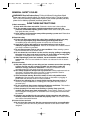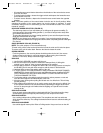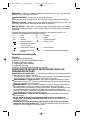
10
• A forward/reverse control button determines the direction of the tool and also serves
as a lock off button.
• To select forward rotation, release the trigger switch and depress the forward/reverse
control button to the left.
• To select reverse direction, depress the forward/reverse control button the opposite
direction.
Note: The center position of the control button locks the tool in the off position. When
changing the position of the control button, be sure the trigger is released. To avoid
screwdriver being turned on accidentally, put the forward/reverse button in the center,
locked-off, position.
HIGH/LOW SPEED SELECTOR (FIGURE G)
The dual range feature of your tool allows you to shift gears for greater versatility. To
select low speed, high torque setting (position 1), turn tool off and permit to stop. Slide
gear shifter button to the left.
To select the high speed, low torque setting (position 2), turn tool off and permit to stop.
Slide gear shifter button to the right.
NOTE: Do not change gears when tool is running. If you are having trouble changing
gears, make sure that the dual range gear button is either completely pushed to the right
or to the left.
QUICK RELEASE COLLAR (FIGURE H)
NOTE: The collar accepts 1/4" hex accessories only.
To install a bit, pull the collar back and insert the bit into the collar until it locks into place.
To remove a bit, pull the collar back. Remove the bit and release the collar.
SCREW DRIVING
For driving fasteners, the reversing button should be pushed to the left. Use reverse
(button pushed to the right) for removing fasteners. When moving from forward to
reverse, or vice versa, always release the trigger switch first.
DRILLING
1. Use BLACK & DECKER hex shank drill bits only.
2. Be sure the material to be drilled is anchored or clamped firmly. If drilling thin
material, use a “back-up” block to prevent damage to the material.
3. Always apply pressure in a straight line with the bit. Use enough pressure to keep the
drill bit biting, but do not push hard enough to stall the motor or deflect the bit.
4. Hold tool firmly to control the twisting action of the drill.
5. IF TOOL STALLS, it is usually because it is being overloaded. RELEASE TRIGGER
IMMEDIATELY, remove drill bit from work, and determine cause of stalling. DO NOT
CLICK TRIGGER OFF AND ON IN AN ATTEMPT TO START A STALLED TOOL –
THIS CAN DAMAGE THE TOOL.
6. To minimize stalling or breaking through the material, reduce pressure on tool and
ease the bit through the last fractional part of the hole.
7. Keep the motor running when pulling the bit back out of a drilled hole. This will help
prevent jamming.
8. With variable speed drills there is no need to center punch the point to be drilled. Use
a slow speed to start the hole and accelerate by squeezing the trigger harder when
the hole is deep enough to drill without the bit skipping out. Operate at full on after
starting the bit.
DRILLING IN WOOD
Holes in wood can be made with hex shank twist drill bits. These bits should be sharp
and should be pulled out frequently when drilling to clear chips from the flutes.
DRILLING IN METAL
Use a cutting lubricant when drilling metals. The exceptions are cast iron and brass
which should be drilled dry. The cutting lubricants that work best are sulfurized cutting oil
or lard oil.
DRILLING IN MASONRY
Use carbide tipped masonry bits. Refer to Drilling section. Keep even force on the drill
90519813 VPX1101 Screwdriver 7/11/07 8:47 AM Page 10


















